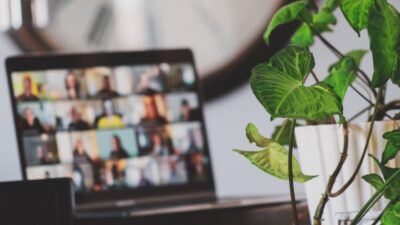Even before COVID-19, executives and leaders were already feeling a change in the air. Big data, A.I., and robotics were being threaded together by even faster networking. The fourth industrial revolution was coming whether they liked it or not.
Before COVID-19 the major 21st century challenges facing leaders were the ‘gifts’ of the fourth industrial revolution – big data, AI, robotics.
But the true instigator of change in the first half of the 2020 has been adversity and human hardship.
In mere months, collaborative remote working was the new normal, cinema goers became Netflix subscribers, online lessons and tele-health moved from a technological possibility to a necessity, contactless payment were no longer seen as a convenience but a ticket to play.
Transformation is essential but can lead to the mistaken urge to jettison ‘yesterdays’ people: If COVID-19 has taught us anything, it’s that now is the time for organisations to take more care of their people.
Here are three thought starters to harnessing people’s natural adaptiveness while keeping them inspired and motivated:
1. Harness the brand for continuity and buy-in
Successful brands – Apple, Louis Vuitton, PayPal – provide stories that bring people together to achieve what they can’t alone. Speaking to a greater purpose can galvanise people towards a common goal during difficult times – especially if it comes from the organisation’s DNA.
2. Find and connect your helpful hybrids and equip them to lead
Change champions exist at all levels in an organisation: They share the trait of being ‘helpful hybrids’ with established and trusted relationship networks while exploring new ways of working.
3. Build momentum from the ground up through micro-behaviours and perspectives
Start the change process in ‘small’ ways but with the purposeful aim of breaking old habits, opening the door to new ways of thinking and behaving. At Amazon Jeff Bezos’ rule of no PowerPoint meetings drove new engagement and ideas.
We are psychologically wired to focus on the negatives before thinking how we can break down the problem into manageable bites. Shift your mindset. Make the most of what you already have, connect it in new ways, and make little changes to take the next step. Most of all, take care of your people and they will take care of your organisation.
But the true instigator of change in this first half of 2020 has been adversity and human hardship. In mere months, collaborative remote working through the cloud became a reality for many, cinema goers became first time Netflix subscribers, online lessons moved from a technological possibility to a necessity, tele-health became an essential service and things like contactless payment were no longer seen as a future convenience but a ticket to play.
Because of this, the concept of ‘transformation’ – the technological, cultural and structural changes needed to optimise an organisation for a digital world connected around the consumer, became an imperative overnight. But with all pressing necessities come fear and anxiety. Is my organisation still relevant? How do I invest in radically new capabilities? Is this even the right time amidst this economic outlook? At its best this might cause hesitation and inertia. At its worst it can lead to an ‘in with the new, out with the old’ approach. This demotivates and undervalues people who have given their knowledge and effort to make the organisation what it is today. And this is a big mistake because it is in fact people who make organisations creative, productive and adaptive. If COVID-19 has taught us anything, it’s that now is the time for organisations to take more care of their people.
So how might you harness people’s natural adaptiveness to move with the times, while keeping them inspired and motivated?
Here are three thought-starters.
1. Harness the brand for continuity and buy-in
A brand is more than a customer-facing visual and verbal experience. This concept also encompasses employees’ perception of what makes the company unique and what principles and beliefs they would stand by: from Louis Vuitton to Brunello Cucinelli, from Apple, to PayPal and Tesla. People do want to work for them, and it’s not necessarily for better pay. These brands provide stories that bring people together to achieve what they can’t alone or overcome diversity, ‘Intersubjective realities’ as Prof Yuval Noah Harari puts it.
These stories are essential to inspiration and collaboration especially in times of change. The brand also provides people from diverse disciplines a common language and starting point, as well as a network of emotional ties. Speaking to a greater purpose can help galvanise people towards a common goal at a difficult time – especially if it comes from the organisation’s DNA. But key to this is sincerity, not blanket slogan-like statements that mean little. Many have seen the ‘Every COVID commercial is the same’ video circulating on the internet – a classic example of what to avoid. Any appeal to brand has to be backed up by action and tangible evidence of change.
Tsutaya is one of Japan’s largest retailers of books and entertainment with 1,400 shops nationwide. Started in 1983, they had a vision of creating a ‘platform to offer info on new lifestyles’. Today, their bookshops continue to grow even as the future of print media is placed in doubt and they’ve successfully focused their business model away from their core of DVD rentals. By creating continuity between their brand vision and evolving it to ‘suggesting’ new lifestyles to the Japanese public rather than mere information, they galvanised their employees to embrace a new direction and also harnessed data from their T-Card (a loyalty card with more than 60m active users) to create innovative new revenue generating spaces like Daikanyama T-site combining rest space, cafe and bookshop.
2. Find and connect your helpful hybrids and equip them to lead
Every change needs its champions. Understand where people who have the mindsets and capabilities to help push the organisation forward reside. It’s often these people who are helpful hybrids, having established relationship networks and gained the trust of experienced employees with decades of history, while exploring new ways of working and new mindsets. Neglecting these people is not just a waste of great talent, it sends a clear signal to the rest of the company and causes panic.
You will find change champions at all levels in the organisation. A search on “innovation champion” gives over 300,000 results on Google Scholar. To embed new technology and innovation, a champion is particularly useful in your organisation. Map them. Ask team leaders and managers who they are. In our experience, they can reside as far as the call center, or as near as a few people on the C-suite who are eager to turn a new leaf.
Isador Sharp, founder of Four Seasons, highlights that your frontline people are the eyes and the ears of your organisation. Innovation at the Four Seasons starts with anyone in the frontline being very attentive to reading how the customers feel, whether they’re happy or upset about something that is happening during the stay, and management eager to promptly activate this insight.
By elevating these people either in position or in recognition, and importantly, connecting them to each other, you create a sense of continuity between past, present and most importantly the future.
3. Build momentum from the ground up through micro-behaviours and perspectives.
It can be very difficult to break old habits, even for people who are eager to do something new.
In his famous book, Iconoclast: A Neuroscientist Reveals How to Think Differently , Prof Gregory Berns talks about familiarity, and how being too familiar with a concept of doing things, will make us see the world in a certain way, a way that impedes us to be accepting of innovative ideas. So our bias is first of all cognitive, about mindset.Why would you change the way you have always done things when it took you so long to become a well trusted expert in your field?
In these cases, micro-behaviours, and micro-perspectives, help.
Let’s say we want to make our team more naturally innovative and less process driven. In these cases, it can be beneficial to focus on small ‘rituals’ and behaviours that might seem inconsequential but yield big results. These can simply mean running meetings without meticulously crafted PowerPoint decks (these make it seem like decisions have already been made) or using new collaborative tools like Miro, Mural and Mentimeter as proof of a more open culture. Think about Amazon and Jeff Bezos’ rule of no PowerPoint in meetings: at the start of the meeting, participants read a very well crafted written narrative in silence. Toyota’s A-3 method has also spread, facilitating conversations around one A-3 sheet of paper with only essential facts and no distractions.
Micro-perspectives are as important as micro-behaviours. In his latest book The 6 Building Blocks for Successful Innovation, Massimo interviewed innovators from around the world and across industries. He spoke to Mark Nierwetberg, Senior Vice President, Transformation Office Technology & Innovation at Deutsche Telekom who explained:
“We have a small team within Telekom Open Spaces that is empowered to engage with other entities in a special way. They approach universities, researchers, start-ups, companies, and city governments in a non-sales environment. Our team meets with them in a workshop kind of environment where the goal is to educate about digitalisation. It’s really meant to be like an exchange.”
This creates a change in perspective on both sides – a learning and collaboration mindset for the greater good.
From these smaller behaviours, you can go on to build reward and recognition systems, employee experience projects and build a broader cultural change from the ground up.
As transformation has become a necessity we are psychologically wired to focus on the negatives and the risks before thinking how we can break down the problem into manageable bites. A shift in mindset is helpful. Make the most of what you already have, connect it in new ways, and make little changes to take the next step. Most of all, take care of your people and they will take care of your organisation.
This is part of a series of insights related to Coronavirus (COVID-19) and its impact on business.
Image: Liam Briese






